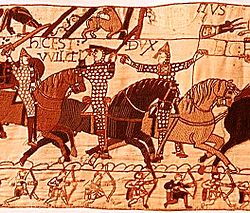Feigned retreat

Bayeux Tapestry fragment showing Duke William (center) "here is Duke William", showing him turning the Normans back into the battle
A feigned retreat is a military tactic where a force will pretend to be defeated, fake a retreat, then while they are being pursued, turn and ambush the enemy.[1] It can be used to cause confusion in the enemy ranks or to force some to leave and weaken their battle formations.[2] Battlefield commanders have had to use this tactic carefully so the feigned retreat did not become a real retreat.[2] It was a tactic used in ancient history and is still being used today.[1] Sun Tzu wrote about it in his book The Art of War. He warned his readers: "When some are seen advancing and some retreating, it is a lure."[3]
In history[change | change source]
- At the Battle of Salamis in 480 BC, the Ancient Greeks were fighting a sea battle with the more numerous Persian navy. Themistocles, the Greek leader, leaked information that was taken back to the Persians that the Greeks were ready to flee and that if the Persians acted right away, they could claim a huge victory.[4] While not an actual feigned retreat but more a rumored one, it worked just as well,[4] as the Persians were defeated.[4]
- At the Battle of Cannae in 216 BC, Hannibal weakened his center on purpose to get the Roman army to attack that point in his lines. As the center fell back slowly, the two stronger wings of the Carthaginian army folded onto the unsuspecting Romans.[5] For the rest of the day, the Carthaginians slaughtered the trapped Romans.
- William the Conqueror ordered two feigned retreats according to William of Poitiers.[6] That was a difficult tactic to use once without causing a complete rout and so it is unlikely he did it twice.[6] It is more likely that William's troops broke ranks and were rallied back into the fight by their leader.[6]The cavalry scene in the Bayeux tapestry shows William with his helmet off with the Latin words Hic est dux Wilelmus (here is Duke Willliam). That supports the theory that the Normans retreated because they believed William had been killed.[7] He pulled his helmet off to show his face and to rally his men back to the battle.[7] Calling it a feigned retreat may have been a politically correct way of saying their army ran away and had to be called back.[6] Nonetheless, many Anglo-Saxon soldiers were foolish enough to chase after William's retreating men but were then killed in the counterattack.[6]
Related pages[change | change source]
- Flanking maneuver
- Pincer movement (also called a double-envelopment)
- Turning movement
- Ambush
- Envelopment
- Flanking maneuver
- Rearguard
- Attrition warfare
- Preemptive war
- Oblique order
- Shock tactics
References[change | change source]
- ↑ 1.0 1.1 Bevin Alexander. "How Wars Are Won; The 13 Rules of War—From Ancient Greece to the War on Terror". Bevin Alexander. Retrieved 27 August 2016.
- ↑ 2.0 2.1 "The Seven Basic Maneuvers of Warfare". Digital Attic. Archived from the original on 17 August 2016. Retrieved 27 August 2016.
- ↑ Sun Tzu. "The Art of War". Internet Classics Archive. Massachusetts Institute of Technology. Archived from the original on 8 March 2018. Retrieved 27 August 2016.
- ↑ 4.0 4.1 4.2 "The Great Conversation: Battle/Debate Tactics–Feigned Retreat". Associate's Mind. Retrieved 27 August 2016.
- ↑ Gregory Daly, Cannae: The Experience of Battle in the Second Punic War (London; New Yori: Routledge, 2002), p. 39
- ↑ 6.0 6.1 6.2 6.3 6.4 Steve Beck. "The Battle of Hastings". MilitaryHistoryOnline.com, LLC. Retrieved 27 August 2016.
- ↑ 7.0 7.1 "The Bayeux Tapestry". A History of the World. BBC. Retrieved 28 August 2016.
